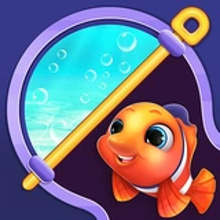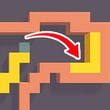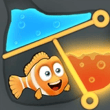🎣🧩 Hooks, hunches, and that perfect tug
The bobber kisses the surface, the line hums like a piano wire, and somewhere below the glitter of the waves a shadow blinks and changes your whole plan. Fishing Master is a Puzzle Game about angles and audacity—threading a hook through miniature mazes of kelp, rocks, and clockwork contraptions, then timing the pull so everything you arranged pays off in one smooth reel. It’s not about luck; it’s about solving water. On Kiz10, inputs are crisp, so a millimeter nudge translates into a miracle line that slips past trouble like it owes you a favor.
🌊🧭 Water that thinks back
Every level is a small ecosystem with opinions. Slow currents nudge your hook like a polite suggestion; rip tides yank it three lanes left just as you were getting cocky. Bubbles mark updrafts that lift the line into a different layer, while eddies hide tiny shortcuts if you enter at the right angle. Even the light matters—a glint across a rock hints at a hidden groove that will tuck your leader into safety if you commit. The fun is reading the river the way a chess player reads diagonals.
🪝⏱️ Timing is a verb
Pressing reel isn’t the action; releasing it is. Tap and release to let the hook drift, then feather tension to snake through a gap that looked illegal five seconds ago. Pull too soon and you’ll scrape a barnacle that flips the whole plan; pull too late and the fish wanders into a gear that was minding its own business until you weren’t. The best levels play like music: cast on the downbeat, drift on two, tap the bobber at three-and-a-half, finish with a clean lift that feels like a cymbal kiss.
🐟🔀 Fish with personalities, not hit points
No anonymous loot here. Skittish minnows dart if your line shadows them; you’ll learn to approach from below and off-angle. Bottom dwellers tolerate proximity but panic at sudden tugs—let the hook rest a second, then nudge. Jelly-like floaters bounce the line on contact, which is rude but usable if you need a physics reset. Trophy fish test everything at once: they lurk behind rotating paddles or within a ring of spined urchins that punish greed. Read their routes, match their moods, and your first clean capture will feel like outsmarting a tiny genius.
🧠💡 Puzzles in plain sight
Levers control sluice gates that rewrite current paths; mirrors redirect sunbeams to open photosensitive clams; ticking gears periodically change the safe lane from “no way” to “now.” A cracked bottle serves as a one-way tunnel if you enter with the line slack; a rusted anchor becomes a pendulum if you clip it just right, swinging your hook under a spike field while you grin at the audacity. None of it is complicated alone; all of it together becomes a delicious riddle you solve with wrists and patience.
🎯🌪️ Combos, chains, and the elegance of greed
Catching one fish is nice. Catching three in a single arc without touching a hazard is poetry. Chain catches by plotting a loop: tag a minnow, let the line relax into a bubble elevator, swing left on the outdraft, snag a striped runner, then coast into a slow eddy where the big one loiters. The game rewards variety—different species, different depths, no bump damage—for combo multipliers that elevate “clean plan” into “legendary clip.” Pull it off once and you’ll chase the feeling for hours.
🗺️🏝️ Biomes that teach without talking
Reed Marsh is the tutorial the world deserves—soft current, forgiving gaps, early lessons in slack control. Coral Alley adds rigid lanes, turning your hook into a key searching for its lock. Clockwork Reef introduces moving hazards and levers you can flip with the weight of the line itself. Crystal Trench runs vertical, where updrafts become elevators and every misread puts you face-to-face with stalactite logic. Night Bay flips the lighting; silhouettes guide you more than textures, and fish gleam like constellations that happen to be hungry.
⚙️🔧 Tackle that feels like tool, not gimmick
Swappable lures change arc behavior: a spoon flutters on slack, perfect for baiting timid targets; a jig dives sharper, great for narrow slots; a feather stays lofted in updrafts for slow, precise work. Leaders adjust friction—braid holds angle under pressure; mono slides like butter through coral but hates abrasion. Floats aren’t decorations: a heavier bobber stabilizes in chop; a slim one rides currents for free routing. None of it is mandatory, all of it is personality. You’ll find a loadout that feels like handwriting.
🔊🎵 Sound that coaches your thumb
Currents hum at different notes; you’ll start to hear when an eddy is strong enough to carry you across. A soft click signals the line grazing rock; back off tension and it stops scolding you. Bubbles chirp just before they pop, so you can time a last-second lift into a safe pocket. A captured fish adds a tiny bell that pings in rhythm with its heartbeat; reel too hard and the bell stutters—a gentle “easy now.” With headphones, you’ll pilot by ear as much as by sight.
🧪🏆 Challenges that make you smarter, not angry
Optional goals layer atop clears. Take only surface fish. No slack for five seconds. Collect three shells on the way down and still catch the target in one lift. None of these change the rules; they ask you to express mastery differently. Medals track cleverness, cleanliness, and style. Silver is “I solved it.” Gold is “I solved it without leaving fingerprints.”
♿✅ Clear water, fair cues, friendly options
Color-safe species tints keep silhouettes distinct even at night. A high-contrast toggle thickens line and hazard edges. Vibration pips (where supported) confirm perfect tension windows and warn just before abrasion risk spikes. Aim assist can soften overcorrections on the stick without solving the puzzle for you. Accessibility isn’t a cheat; it’s respect for different hands and eyes.
🧭✨ Micro-habits of players who never blame luck
Cast short first to read current—a recon throw saves five resets. Approach targets from the direction their tails point; it’s the calmer side. If a gap keeps slapping your line, enter earlier with more slack; water prefers patience over force. Rest the hook near a skittish fish until it forgets you exist; move on the breath out. And if everything goes to seaweed, reverse the route—many lanes are easier backward, which feels like cheating only until it works.
🐙🚫 When plans tangle (and how to un-knot them)
Snagged behind a rock? Feather slack, nudge left, and let the current unwrap you instead of yanking. Jelly bounce looped the line into nonsense? Use a heavier bobber to dampen the rebound next attempt. Missed a lever timing? Park the hook in a safe eddy and count the gear cycle—most puzzles run on fours; move on three and you’ll thread it. If a trophy fish bullies you into a hazard, swap to a glidey spoon and approach from above; gravity becomes your ally in politeness.
🌈📸 Vibes that invite screenshots
Bioluminescent algae paint your wake with comet trails when you reel clean. Sunbeams shatter into coins of light when you pass under rock arches. A perfect combo prompts a shy rainbow lens flare that feels less like a reward and more like the ocean nodding. UI stays quiet—small species icons, a tasteful combo meter, a gently pulsing tension band that never yells. The screen belongs to water and your idea slicing through it.
🏁🎣 One cast before you call it
Give yourself a tiny dare. Catch three different species in one arc without touching coral. Thread Clockwork Reef’s second lever on the downbeat, not the up. Land a Night Bay gold with audio cues first, vision second. Breathe on the cast, trust the drift, and tug only when the line sings yes. When the bobber dips, the bell pings true, and your hook rises with a glittering parade of fish that feels like you solved a poem, let yourself grin. Then queue the next pond. Fishing Master on Kiz10 makes puzzles feel fluid, patience feel powerful, and every perfect pull like the ocean telling you “good plan.”
 Obby Fishing: C
Obby Fishing: C













































